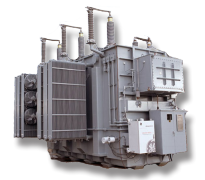Troubleshooting Guide: Transformers
Dissolved Gas Analysis
Over time, a transformer’s insulating materials and electrical equipment begin to degrade, dissolving gases into the unit’s oil. The rate and distribution of these generated gases ultimately leads to transformer failure. We’ve listed the six most common DGA results, and the corresponding solutions that will extend the life of your equipment.
- High carbon monoxide content observed in the DGA

Probable cause: Inefficient cooling, overloading
Solution: Inspect the cooling system, replace the pump and/or valves -
High oxygen content observed in the DGA
Probable cause: Worn gaskets
Solution: Inspect for potential arcing or corona, replace the gaskets -
High ethylene, methane, and/or ethane content observed in the DGA
Probable cause: Overheated or worn load tap changer (LTC) contact
Solution: Check the LTC operation, inspect and replace the LTC contact -
Low levels of acetylene observed in the DGA
Probable cause: Short in the oil pump motor
Solution: Inspect and replace the LTC contact and motor; check for arcing, overloading -
High moisture content observed in the DGA
Probable cause: Worn or faulty gaskets, leaking air cell, spent desiccant, overloading
Solution: Inspect gaskets, air cells and silica gel; replace necessary parts -
Acetylene detected in the LTC oil DGA
Probable cause: Vacuum bottle failure, arcing
Solution: Inspect and replace the faulty vacuum bottles
Transformer Oil
Transformer oil is used for its chemical properties and dielectric strength, acting as an insulator/ cooling agent. It should be tested periodically to prevent costly downtime.
We’ve listed eight common problems with oil test results, levels and accumulation, and corresponding parts to extend the life of your transformers.
- Oil contamination from the main tank into the LTC (migration)

Probable cause: Faulty seal between the LTC compartment and the main tank
Solution: Inspect and replace the tap board and gaskets - Oil temperature alarm, no oil flow alarm, and/or tripping fan motor
Probable cause: Faulty temperature switch, failed oil pump and/or motor, failed fans
Solution: Inspect and replace the temperature gauge, pump, pump motor and fans - Oil accumulation in/around the control cabinet
Probable cause: Gasket leaks
Solution: Inspect and replace gaskets - Bushing oil level is low
Probable cause: Overheated gaskets
Solution: Inspect and replace the Bushing/bushing gaskets -
Low oil level and/or leaks
Probable cause: Faulty gaskets, overloading
Solution: Inspect and replace the all gaskets on the main tank -
Contaminated oil
Probable cause: Faulty oil pump
Solution: Inspect oil pump for leaks, replace if necessary -
Low oil level for the sealed conservator system
Probable cause: Overloading, failing radiator
Solution: Inspect and replace the radiator valves and gaskets
Gauges and Alarms
The transformer’s gauges and alarms monitor and alert to various vitals, such as oil level, oil and winding temperatures, pressure or vacuum in the tank, oil flow and more.
We’ve listed three common gauge and alarm issues and the corresponding solution to extend the life of your transformers.
- Inaccurate gauge operation
Probable cause: Cracked face or glass, stuck needle
Solution: Inspect and replace affected gauges - Pressure vacuum gauge at zero
Probable cause: Check the gauge operation
Solution: Inspect and replace the pressure vacuum gauge - Nitrogen pressure alarm
Probable cause: Faulty gaskets; check the nitrogen bottle
Solution: Inspect and replace the pressure vacuum gauge
Power and Voltage
A transformer’s power and voltage are defined by the amount needed to keep equipment running properly. Fluctuations in these can lead to incorrect diagnosis, accessory failure or unit failure. We’ve listed two potential issues and the solutions to them.
- Capacitance increases and/or there is abnormal tap voltage
Probable cause: Cracked face or glass, stuck needle
Solution: Inspect and replace affected gauges - The power factor is increasing
Probable cause: Check the gauge operation
Solution: Inspect and replace the pressure vacuum gauge
Other Concerns
If your transformer’s problem is not listed, please call us at 800-727-8443 to speak with our technical specialists.
- Non-OSHA approved fan guards
Probable cause: Inspect fan guards to ensure they meet OSHA standards
Solution: Replace fan guards - Abnormal number of LTC operations
Probable cause: Defective LTC control
Solution: Inspect mechanical control components, replace the LTC control
*For more information, please print out our troubleshoot guide.